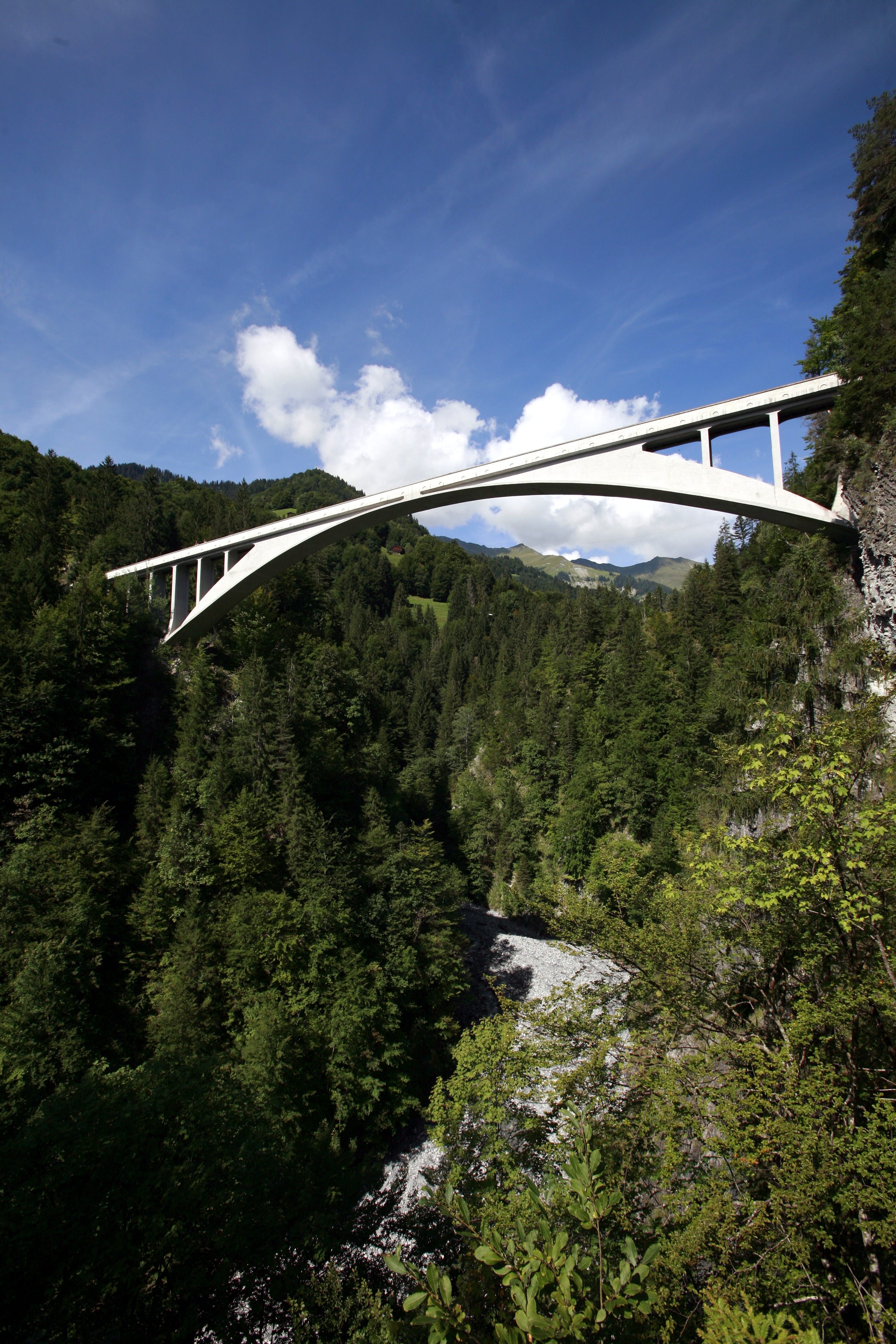- Salginatobel Bridge
Infobox Bridge
bridge_name = Salginatobel Bridge
caption = Southeast view, from an angle
official_name =
carries =
crosses = Salgina Valley
locale =Schiers, Switzerland
maint =
id =
designer =Robert Maillart
design = three-hingedreinforced concrete arch bridge with abox girder
material =reinforced concrete
spans = 1
pierswater =
mainspan = convert|90|m
length = convert|133|m
width =
height =
load =
clearance =
below =
traffic =
begin = 1929
complete = 1930
open = 1930-08-13
closed =
toll =
map_cue =
map_
map_text =
map_width =
coordinates = coord|46|58|54.55|N|9|43|3.81|E|type:landmark|display=inline,title
lat =
long =Salginatobel Bridge is a
reinforced concrete archbridge designed by renowned Swisscivil engineer Robert Maillart . It was constructed across an alpine valley inSchiers, Switzerland between 1929 and 1930. In 1991, it was declared an International Historic Civil Engineering Landmark, the thirteenth such structure and the first concrete bridge so dedicated.Billington, 2003, p.60]As with his
Schwandbach Bridge andVessy Bridge , the structure's fame among civil engineers is a consequence of the techniques involved in its design rather than its prominent location: it serves an obscure town whose population does not break the triple digits.Design and history
Maillart had previously designed a three-hinged arch bridge over the
Rhine atTavanasa in 1904. In the 51m span Tavanasa bridge, the arch is thinnest at its crown and springing points, thickening in between to reflect the shape of itsbending moment diagram.Billington, 1990, p. 12] This bridge was destroyed by an avalanche in September 1927. Although Maillart didn't win the contract for a replacement bridge, he entered a competition the following year for the bridge at Salginatobel, with a three-hinged arch spanning 90m that used the same overall form as at Tavanasa. In conjunction with builder Florian Frader, Maillart's design was the least expensive of nineteen entries.Billington, 1983, p.160]The Salginatobel bridge arch is 133m long in total, and its main element is a hollow concrete box girder over the central part of the arch.Figi, p.21] It carries a roadway 3.5m wide, supported on reinforced concrete pillars above the ends of the arches.
The bridge was officially opened on
August 18 ,1930 . Although regarded as a pioneering work, several aspects of its construction lacked durability, such as the absence of bridge deckwaterproofing , lowconcrete cover and poor drainage. In 1975 and 1976 it was extensively repaired, theparapet s were modified, and waterproofing was added.Figi, p.22] However, by 1991, deterioration had continued, with the parapets becoming unsafe. The waterproofing and drainage were replaced and amended, and most of the existing concrete surface removed and replaced byshotcrete . The parapets were completely rebuilt. Completed in 1998, this repair work cost 1.3 million US dollars.Praise & Criticism
The bridge has received considerable praise from other bridge engineers. Writing in 2000, Heinrich Figi said:
"From a conceptual point of view, the Salginatobel Bridge is an excellent structure".
David P. Billington has been particularly enthusiastic about the bridge:Billington, 1991, p.46]
"Its visual elegance ... goes together with its technical brilliance."
"Such works at Maillart's, being at the very highest level of engineering achievement and being works of art, must be protected."
However, the great German bridge engineer
Fritz Leonhardt has suggested that:Leonhardt, p.217]"These Maillart-type arch bridges only look good in special situations as here over a gorge and against a mountainous background."
Maillart himself was also not entirely satisfied with the bridge, writing after its completion that its
soffit should have been a pointed rather than a pure curved arch, if it were properly to match his structural analysis:Maillart, pp. 303-4, cited in Billington, 2003, p. 60]"Even the [Salginatobel Bridge] cannot lay claim to complete sincerity of form. Indeed, if both constant and shifting weights are taken into consideration, the extreme curves of exerted pressures form two lenticular surfaces whose lower contours meet at an acute angle."
References
* [http://www.asce.org/history/brdg_salginatobel.html History of Civil Engineering page on the bridge]
* Billington, David P. "Maillart and the Salginatobel Bridge". Structural Engineering International, 1/1991.
* Billington, David P. "The Tower and the Bridge". Princeton University Press, Princeton, USA, 1983. ISBN 0-691-02393-X
* Billington, David P. "Robert Maillart and the Art of Reinforced Concrete". The MIT Press. Cambridge, USA, 1990. ISBN 0-262-02310-5.
* Billington, David P. "The Art of Structural Design: A Swiss Legacy." Princeton University Art Museum. Princeton, USA, 2003. ISBN 0-300-09786-7.
* Figi, Heinrich. "Rehabilitation of the Salginatobel Bridge". Structural Engineering International, 1/2000.
* Leonhardt, Fritz. "Bridges: Aesthetics and Design". The MIT Press, Cambridge, USA, 1984. ISBN 0-262-12105-0
* Maillart, Robert. "Construction and Aesthetic of Bridges". The Concrete Way, May-June 1935.Notes
External links
* (includes construction photo)
* [http://www.asce.org/history/brdg_salginatobel.html ASCE: History and Heritage of Civil Engineering]
* [http://www.greatbuildings.com/buildings/Salginatobel_Bridge.html Great Buildings Online]
*
Wikimedia Foundation. 2010.
